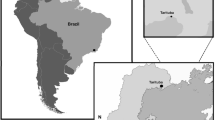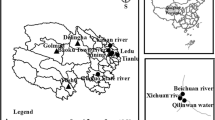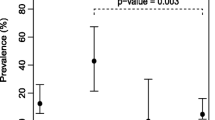Abstract
Bivalve mollusks are filter-feeding animals that are often consumed raw or partially cooked. They can harbor a wide variety of microorganisms such as the pathogenic protozoa Giardia and Cryptosporidium . Both these pathogens are well-known causative agents of diarrhea in humans and have been associated with several water and foodborne outbreaks around the world. Their infective stages, cysts and oocysts , respectively, can remain on the gills and other organs of shellfish , posing a potential threat to human health. There is no standard protocol or valid ISO for the detection of cysts and oocysts from shelled mollusks . The aim of this chapter is to describe the main methods used to detect Giardia cysts and Cryptosporidium oocysts from shellfish , based on techniques adapted from clinical and environmental parasitology, as well as molecular procedures. The monitoring of these foodborne protozoa in bivalve mollusks is of great relevance to public health , contributing to knowledge of contamination in one of the main food products derived from aquaculture. Indeed, it also reflects the quality of the environmental health surrounding its cultivation, highlighting another important aspect related to global environmental epidemiology.
Access this chapter
Tax calculation will be finalised at checkout
Purchases are for personal use only
Similar content being viewed by others
References
FAO Food and Agriculture Organization of the United Nations (2020) The state of world fisheries and aquaculture. Sustainability in action. https://doi.org/10.4060/ca9229en. Accessed 21 Sep 2020
Potasman I, Paz A, Odeh M (2002) Infectious outbreaks associated with bivalve shellfish consumption: a worldwide perspective. Clin Infect Dis 35(8):921–928. https://doi.org/10.1086/342330
Souza DSM, Ramos APD, Nunes FF et al (2012) Evaluation of tropical water sources and mollusks in southern Brazil using microbiological, biochemical, and chemical parameters. Ecotoxicol Environ Saf 76(2):153–161. https://doi.org/10.1016/j.ecoenv.2011.09.018
Leal DAG, Souza DSM, Caumo KS et al (2018) Genotypic characterization and assessment of infectivity of human waterborne pathogens recovered from oysters and estuarine waters in Brazil. Water Res 137:273–280. https://doi.org/10.1016/j.watres.2018.03.024
Palos Ladeiro M, Bigot-Clivot A, Geba et al (2019) Mollusc bivalves as indicators of contamination of water bodies by protozoan parasites. In: Encyclopedia of environmental health, vol 4, 2nd edn. Elsevier, pp 443–448. https://doi.org/10.1016/B978-0-12-409548-9.10979-0
Nappier SP, Graczyk TK, Tamang L et al (2009) Co-localized Crassostrea virginica and Crassostrea ariakensis oysters differ in bioaccumulation, retention and depuration of microbial indicators and human enteropathogens. J Appl Microbiol 108(2):736–744. https://doi.org/10.1111/j.1365-2672.2009.04480.x
WHO World Health Organization (2010) In: Rees G, Pond K, Kay D, Bartram J, Santo Domingo J (eds) Safe management of shellfish and harvest waters. International Water Association Publishing, London
Leal DAG, Ramos APD, Souza DSM et al (2013) Sanitary quality of edible bivalve mollusks in Southeastern Brazil using an UV based depuration system. Ocean Coast Manag 72:93–100
Oliveira J, Cunha A, Castilho F et al (2011) Microbial contamination and purification of bivalve shellfish: crucial aspects in monitoring and future perspectives – a mini-review. Food Control 22(6):805–816. https://doi.org/10.1016/j.foodcont.2010.11.032
Souza DSM, Piazza RS, Pilotto MR et al (2013) Virus, protozoa and organic compounds decay in depurated oysters. Int J Food Microbiol 167(3):337–345. https://doi.org/10.1016/j.ijfoodmicro.2013.09.019
Chalmers RM, Sturdee AP, Mellors P et al (1997) Cryptosporidium parvum in environmental samples in the Sligo area, Republic of Ireland: a preliminary report. Lett Appl Microbiol 25(5):380–384. https://doi.org/10.1046/j.1472-765x.1997.00248.x
Fayer R, Graczyk TK, Lewis EJ et al (1998) Survival of infectious Cryptosporidium parvum oocysts in seawater and eastern oysters (Crassostrea virginica) in the Chesapeake Bay. Appl Environ Microbiol 64(3):1070–1074
Robertson LJ (2007) The potential for marine bivalve shellfish to act as transmission vehicles for outbreaks of protozoan infections in humans: a review. Int J Food Microbiol 120(3):201–216. https://doi.org/10.1016/j.ijfoodmicro.2007.07.058
Certad G, Viscogliosi E, Chabé M et al (2017) Pathogenic mechanisms of Cryptosporidium and Giardia. Trends Parasitol 33(7):561–576. https://doi.org/10.1016/j.pt.2017.02.006
Trevisan C, Torgerson PR, Robertson LJ (2019) Foodborne parasites in Europe: present status and future trends. Trends Parasitol 35(9):695–703. https://doi.org/10.1016/j.pt.2019.07.002
Ryan U, Hijjawi N, Feng Y et al (2019) Giardia: an under-reported foodborne parasite. Int J Parasitol 49(1):1–11. https://doi.org/10.1016/j.ijpara.2018.07.003
Ahmed SA, Karanis P (2018) An overview of methods/techniques for the detection of Cryptosporidium in food samples. Parasitol Res 117:629–653. https://doi.org/10.1007/s00436-017-5735-0
Widmer G, Carmena D, Kváč M et al (2020) Update on Cryptosporidium spp.: highlights from the seventh international Giardia and Cryptosporidium conference. Parasite 27:14. https://doi.org/10.1051/parasite/2020011
Thompson RCA, Ash A (2019) Molecular epidemiology of Giardia and Cryptosporidium infections – what’s new? Infect Genet Evol 75:103951. https://doi.org/10.1016/j.meegid.2019.103951
Rousseau A, La Carbona S, Dumètre A et al (2018) Assessing viability and infectivity of foodborne and waterborne stages (cysts/oocysts) of Giardia duodenalis, Cryptosporidium spp., and Toxoplasma gondii: a review of methods. Parasite 25:14. https://doi.org/10.1051/parasite/2018009
Cernikova L, Faso C, Hehl AB (2018) Five facts about Giardia lamblia. PLoS Pathog 14(9):e1007250. https://doi.org/10.1371/journal.ppat.1007250
Tamburrini A, Pozio E (1999) Long-term survival of Cryptosporidium parvum oocysts in seawater and in experimentally infected mussels (Mytilus galloprovincialis). Int J Parasitol 29(5):711–715. https://doi.org/10.1016/S0020-7519(99)00033-8
Hamilton KA, Waso M, Reyneke B et al (2018) Cryptosporidium and Giardia in wastewater and surface water environments. J Environ Qual 47(5):1006–1023. doi: https://doi.org/10.2134/jeq2018.04.0132
Gómez-Couso H, Freire-Santos F, Martínez-Urtaza J (2003) Contamination of bivalve molluscs by Cryptosporidium oocysts: the need for new quality control standards. Int J Food Microbiol 87(1–2):97–105. https://doi.org/10.1016/s0168-1605(03)00057-6
Palos Ladeiro M, Bigot A, Aubert D et al (2013) Protozoa interaction with aquatic invertebrate: interest for watercourses biomonitoring. Environ Sci Pollut Res Int 20(2):778–789. https://doi.org/10.1007/s11356-012-1189-1
Ligda P, Claerebout E, Robertson LJ et al (2019) Protocol standardization for the detection of Giardia cysts and Cryptosporidium oocysts in Mediterranean mussels (Mytilus galloprovincialis). Int J Food Microbiol 298:31–38. https://doi.org/10.1016/j.ijfoodmicro.2019.03.009
Kaupke A, Osiński Z, Rzeżutka A (2019) Comparison of Cryptosporidium oocyst recovery methods for their applicability for monitoring of consumer-ready fresh shellfish. Int J Food Microbiol 296:14–20. https://doi.org/10.1016/j.ijfoodmicro.2019.02.011
Freire-Santos F, Oteiza-López A, Castro-Hermida J et al (2001) Viability and infectivity of oocysts recovered from clams, Ruditapes philippinarum, experimentally contaminated with Cryptosporidium parvum. Parasitol Res 87:428–430. https://doi.org/10.1007/s004360100382
Gómez-Couso H, Freire-Santos F, Hernandez-Cordova GA et al (2005) A histological study of the transit of Cryptosporidium parvum oocysts through clams (Tapes decussatus). Int J Food Microbiol 102(1):57–62. https://doi.org/10.1016/j.ijfoodmicro.2004.12.002
Géba E, Aubert D, Durand L et al (2020) Use of the bivalve Dreissena polymorpha as a biomonitoring tool to reflect the protozoan load in freshwater bodies. Water Res 170:115297. https://doi.org/10.1016/j.watres.2019.115297
Giangaspero A, Molini U, Iorio R et al (2005) Cryptosporidium parvum oocysts in seawater clams (Chamelea gallina) in Italy. Prev Vet Med 69(3–4):203–212. https://doi.org/10.1016/j.prevetmed.2005.02.006
Leal DAG, Pereira MA, Franco RMB et al (2008) First report of Cryptosporidium spp. oocysts in oysters (Crassostrea rhizophorae) and cockles (Tivela mactroides) in Brazil. J Water Health 6(4):527–532. https://doi.org/10.2166/wh.2008.065
Fayer R, Trout JM, Lewis EJ et al (2003) Contamination of Atlantic coast commercial shellfish with Cryptosporidium. Parasitol Res 89(2):141–145. https://doi.org/10.1007/s00436-002-0734-0
Schets FM, van den Berg HHJL, Engels GB et al (2007) Cryptosporidium and Giardia in commercial and non-commercial oysters (Crassostrea gigas) and water from the Oosterschelde, The Netherlands. Int J Food Microbiol 113(2):189–194. https://doi.org/10.1016/j.ijfoodmicro.2006.06.031
Miller WA, Miller MA, Gardner IA et al (2005) New genotypes and factors associated with Cryptosporidium detection in mussels (Mytilus spp.) along the California coast. Int J Parasitol 35(10):1103–1113. https://doi.org/10.1016/j.ijpara.2005.04.002
Graczyk TK, Lewis EJ, Glass G et al (2007) Quantitative assessment of viable Cryptosporidium parvum load in commercial oysters (Crassostrea virginica) in the Chesapeake Bay. Parasitol Res 100:247. https://doi.org/10.1007/s00436-006-0261-5
Li X, Guyot K, Dei-Cas E et al (2006) Cryptosporidium oocysts in mussels (Mytilus edulis) from Normandy (France). Int J Food Microbiol 108(3):321–325. https://doi.org/10.1016/j.ijfoodmicro.2005.11.018
Robertson LJ, Gjerde B (2008) Development and use of a pepsin digestion method for analysis of shellfish for Cryptosporidium oocysts and Giardia cysts. J Food Prot 71(5):959–966. https://doi.org/10.4315/0362-028x-71.5.959
Schets FM, van den Berg HHJL, de Roda Husman AM (2013) Determination of the recovery efficiency of Cryptosporidium oocysts and Giardia cysts from seeded bivalve mollusks. J Food Prot 76(1):93–98. https://doi.org/10.4315/0362-028X.JFP-12-326
Tei FF, Kowalyk S, Reid JA et al (2016) Assessment and molecular characterization of human intestinal parasites in bivalves from Orchard Beach, NY, USA. Int J Environ Res Public Health 13(4):381. https://doi.org/10.3390/ijerph13040381
Fayer R, Trout J, Lewis EJ et al (2002) Temporal variability of Cryptosporidium in the Chesapeake Bay. Parasitol Res 88(11):998–1003. https://doi.org/10.1007/s00436-002-0697-1
EPA United Stated Environmental Protection Agency (2005) Method 1623.1: Cryptosporidium and Giardia in water by filtration/IMS/FA. https://www.epa.gov/sites/production/files/2015-07/documents/epa-1623.pdf. Accessed 21 Sep 2020
ISO International Organization for Standardization (2006) ISO 15553:2006. Water quality - isolation and identification of Cryptosporidium oocysts and Giardia cysts from water. https://www.iso.org/standard/39804.html. Accessed 21 Sep 2020
Ware MW, Wymer L, Lindquist HDA et al (2003) Evaluation of an alternative IMS dissociation procedure for use with method 1622: detection of Cryptosporidium in water. J Microbiol Methods 55(3):575–583. https://doi.org/10.1016/j.mimet.2003.06.001
Manore AJW, Harper SL, Aguilar B et al (2019) Comparison of freeze-thaw cycles for nucleic acid extraction and molecular detection of Cryptosporidium parvum and Toxoplasma gondii oocysts in environmental matrices. J Microbiol Methods 156:1–4. https://doi.org/10.1016/j.mimet.2018.11.017
Hopkins RM, Meloni BP, Groth DM et al (1997) Ribosomal RNA sequencing reveals differences between the genotypes of Giardia isolates recovered from humans and dogs living in the same locality. J Parasitol 83(1):44–51
Appelbee AJ, Frederick LM, Heitman TL et al (2003) Prevalence and genoty** of Giardia duodenalis from beef calves in Alberta, Canada. Vet Parasitol 112(4):289–294. https://doi.org/10.1016/s0304-4017(02)00422-3
Lalle M, Pozio E, Capelli G et al (2005) Genetic heterogeneity at the beta-giardin locus among human and animal isolates of Giardia duodenalis and identification of potentially zoonotic subgenotypes. Int J Parasitol 35(2):207–213. https://doi.org/10.1016/j.ijpara.2004.10.022
Cacciò SM, de Giacomo M, Pozio E (2002) Sequence analysis of the β-giardin gene and development of a polymerase chain reaction-restriction fragment length polymorphism assay to genotype Giardia duodenalis cysts from human faecal samples. Int J Parasitol 32(8):1023–1030
Sulaiman IM, Fayer R, Bern C et al (2003) Triosephosphate isomerase gene characterization and potential zoonotic transmission of giardia duodenalis. Emerg Infect Dis 9(11):1444–1452. https://doi.org/10.3201/eid0911.030084
Read CM, Monis PT, Andrew Thompson RC (2004) Discrimination of all genotypes of Giardia duodenalis at the glutamate dehydrogenase locus using PCR-RFLP. Infect Genet Evol 4(2):125–130. https://doi.org/10.1016/j.meegid.2004.02.001
Santín M, Trout JM, Vecino JAC et al (2006) Cryptosporidium, Giardia and Enterocytozoon bieneusi in cats from Bogota (Colombia) and genoty** of isolates. Vet Parasitol 141(3–4):334–339. https://doi.org/10.1016/j.vetpar.2006.06.004
Silva SOS, Richtzenhain LJ, Barros IN et al (2013) A new set of primers directed to 18S rRNA gene for molecular identification of Cryptosporidium spp. and their performance in the detection and differentiation of oocysts shed by synanthropic rodents. Exp Parasitol 135(3):551–557. https://doi.org/10.1016/j.exppara.2013.09.003
Author information
Authors and Affiliations
Corresponding author
Editor information
Editors and Affiliations
Rights and permissions
Copyright information
© 2021 The Author(s), under exclusive license to Springer Science+Business Media, LLC, part of Springer Nature
About this chapter
Cite this chapter
Leal, D.A.G., Bonatti, T.R., de Lima, R., Barbosa, R.L., Franco, R.M.B. (2021). Detection of Giardia Cysts and Cryptosporidium Oocysts in Edible Shellfish: Choosing a Target. In: Magnani, M. (eds) Detection and Enumeration of Bacteria, Yeast, Viruses, and Protozoan in Foods and Freshwater. Methods and Protocols in Food Science . Humana, New York, NY. https://doi.org/10.1007/978-1-0716-1932-2_17
Download citation
DOI: https://doi.org/10.1007/978-1-0716-1932-2_17
Published:
Publisher Name: Humana, New York, NY
Print ISBN: 978-1-0716-1931-5
Online ISBN: 978-1-0716-1932-2
eBook Packages: Springer Protocols




